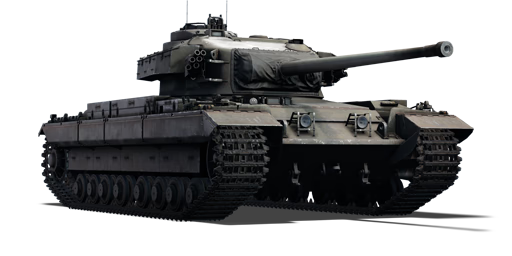



In 1949, work on the chassis for the new "Universal Tank" project was nearing completion. However, development of the gun and turret of what would later become the Conqueror was still yet to begin. In order to expedite testing and training, the new hull was fitted with the 20-pounder-equipped turret of the Centurion Mk 3, producing the FV 221 Caernarvon. Units were sent to the British Army of the Rhine, Bovington, Libya, and the Middle East for troop trials, identifying a number of issues with the chassis design. Once the Conqueror finally entered service in 1955, all Caernarvon units were re-equipped with the new turret and served until the Conqueror's replacement in the 1960s.
Introduced along with the initial British ground tree in Update 1.55 "Royal Armour", the Caernarvon is the heavier counterpart to the early Centurion series, featuring the same firepower and gun handling characteristics, alongside thicker armour and surprisingly adequate mobility for its size. The Caernarvon works well in a supportive, sniping role, utilising its highly penetrating and easy-to-aim cannon to disable opponents from afar, while minimising the chance of damage through the thick armour. However, it can also be effective in more urban brawls, taking advantage of the two-plane gun stabilizer, decent protection, and reasonable mobility, making the Caernarvon a very versatile vehicle for any location or situation.
| Ammunition | Type | Armor penetration (mm) at a distance: | |||||
|---|---|---|---|---|---|---|---|
| 10 m | 100 m | 500 m | 1000 m | 1500 m | 2000 m | ||
| APCBC | 239 | 236 | 222 | 206 | 192 | 178 | |
| HE | 19 | 19 | 19 | 19 | 19 | 19 | |
| APDS | 385 | 381 | 364 | 344 | 325 | 307 | |
| Smoke | 3 | 3 | 3 | 3 | 3 | 3 | |
| Belt | Belt filling | Armor penetration (mm) at a distance: | |||||
|---|---|---|---|---|---|---|---|
| 10 m | 100 m | 500 m | 1000 m | 1500 m | 2000 m | ||
| AP-I/AP-I/AP-T | 9 | 8 | 6 | 3 | 0 | 0 | |












Mobility | |
|---|---|
Protection |
|---|
Firepower | |
|---|---|